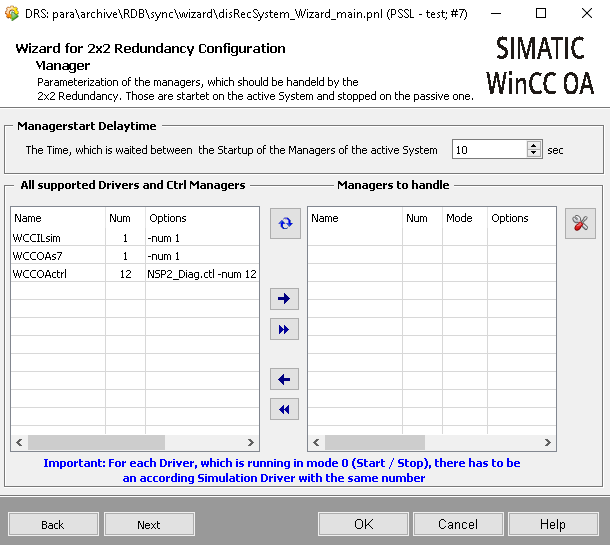Configuration - Step 3 - Managers
Managers
This panel defines all drivers and control managers managed by the disaster recovery system. These managers always only run on the active system and are automatically stopped on the passive system.

Manager start Delay time
This time is waited between each manager start on the active system (cascaded manager start). Using the config entry switchingDriverActiveTimeout you can also define a time here to set the driver connections to active.
All supported Drivers and Ctrl Managers
A list of all supported local drivers and control managers, sourced from the WinCC OA progs file.
No remotely running drivers or control managers will be displayed in this Panel.
Managers to handle
List of drivers and control managers managed by the Disaster Recovery System. Handling means that the selected managers and drivers only run on the active system and are replaced by simulation drivers on the passive system.
During an active/passive switch, all real drivers are stopped and the simulation drivers on the active (now passive) system as well as the real drivers on the new active system are started. These will be stopped at the next change and the real drivers will be started instead of the simulation drivers. This default behavior is called Start / Stop driver mode. The active/passive switching of a driver takes approx. 40 seconds in this mode.
For drivers that support setting their connections to active/inactive at runtime (DNP3, IEC, Modbus, OPC DA, OPC UA DA, S7, SINAUT), the Active / Passive driver mode can be used as an alternative. The active/passive switching of a driver takes approx. 6 seconds in this mode. This driver mode means that when there is an active/passive switch, the real drivers are still running on both systems and only the driver connections are set to active/inactive (usually the “<_DP>.Active” DPE on the internal data point of the driver is set to TRUE/FALSE). Therefore, no simulation driver is required in this mode for the supported drivers.
Connections that were deactivated by the user before the switch (maintenance, etc.) will not be reactivated, but will remain deactivated in the new active system. For drivers that do not support setting a connection to active/inactive, the Start / Stop driver mode is used.
When driver connections are created on one system (active or passive), they are also immediately created on the other system, but are configured cyclically using the DRS system configuration synchronization. Therefore, the configuration of a new driver connection should always be done on the PSS system.
To change the driver mode for any of the above drivers from Start / Stop to Active / Passive, select the driver in the Managers
to handle table and click the  button. This will open the following panel:
button. This will open the following panel:

The third driver mode Active / Standby is only supported for the IEC 104 driver if the config entry SendStartDTwhenPassive = 0 is set. Otherwise it is grayed out. Connections are not set to inactive, but to standby, i.e. only an alive check of the driver connection is performed.
No simulation driver may be used for drivers with mode 1 or 2.
Select the desired driver mode and click OK.
The button  updates both tables of managers.
updates both tables of managers.
Moving managers between the both tables using buttons

This button moves the selected manager from the left table to the right table. The manager is now managed by the disaster recovery system.

This button moves all managers from the left table to the right table. The manager is now managed by the disaster recovery system.

This button moves the selected manager from the right table to the left table. The manager is no longer managed by the disaster recovery system.

This button moves all managers from the right table to the left table. The managers are no longer managed by the disaster recovery system.



